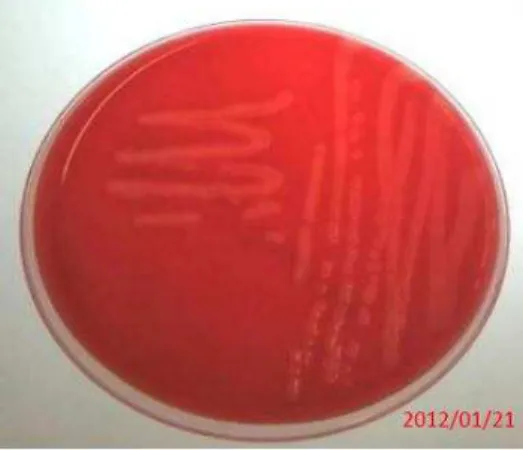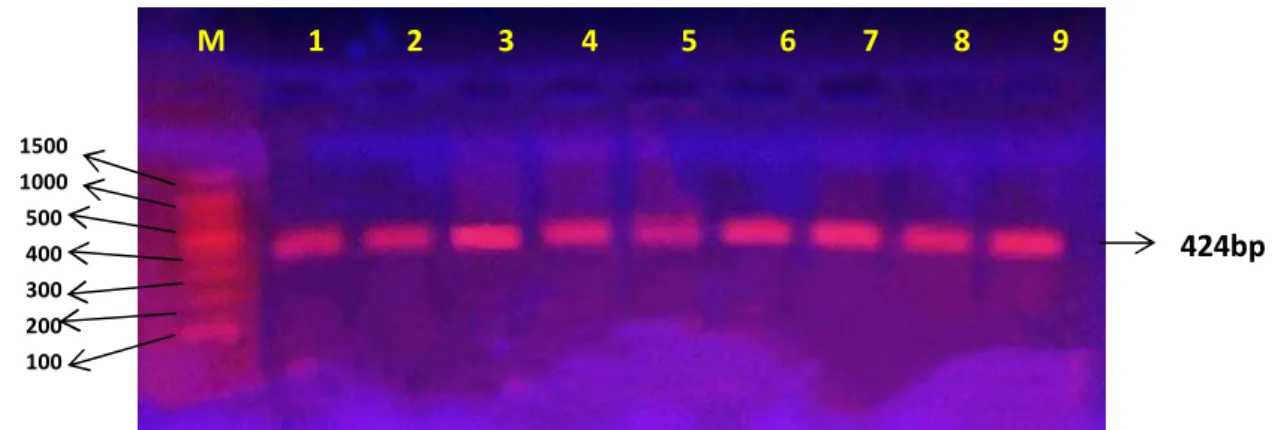SHORT COMMUNICATION
DETECTED OF AERO GENE IN AEROMONASHYDROPHILA ISOLATES FROM
SHRIMP AND PEELED SHRIMP SAMPLES IN LOCAL MARKETS
Alaa Kareem Niamah*
Address: Food Science Dep., Agriculture College, Basrah University, Basrah City, Iraq
*Corresponding author. Tel.:+9647709042069; E-mail: alaakareem2002@yahoo.com
ABSTRACT
A 62 isolates were isolated from 33 samples of shrimp and peeled shrimp in three local markets in Basrah city. A 36 isolates were identified to be Aeromonas hydrophila
bacteria depending on morphological, microscopic examinations and ten biochemical tests. 83.33% (30 isolates) from isolates produced ß-haemolysis on tryptone soy agar with 5% sheep blood. Aero gene detection by polymerase chain reaction technique, Theband appearance in the amplified gene of bacteria shows the molecular weight of aerolysin (424 bp). A 100% (36 isolates) of Aeromonas hydrophila isolates were contained Aero gene.
Keywords: Aeromonas hydrophila,ß-haemolysis, Aero gene
INTRODUCTION
Aeromonas organisms are straight gram-negative rods with occasional filaments. The majority are motile with polar flagellae, however, some strain are non-motile. Aeromonas
species are indigenous to aquatic environments world-wide. The main virulence factors are 3 toxins that are enterotoxins, aerolysin and hemolysin in addition to other factors such as adhesions and mucinase production (Rabaan et al., 2001).
human diseases that vary in severity from a self-limiting gastroenteritis to potentially fatal septicemia (Tsai et al., 2006).
Aerolysin and hemolysin genes are reported to be the putative virulence genes of
A.hydrophila. Aerolysin, produced by some strains of A. hydrophila, is an extracellular, soluble, hydrophilic protein exhibiting both hemolytic and cytolytic properties. Polymerase chain reaction (PCR) technique was used to assay for the detection of aero and hlyA genes in
Aeromonas spp. isolated from environmental and shellfish sources (Yousr et al., 2007). Isolation six types of Aeromonas spp. were diagnosed from tap water in Basrah City which including: A. hydrophila (35 isolates) dominant species isolated from 9 districts, 32 isolates of A. caviae, 26 isolates of A. schubertii , and 21 isolates of A. eucrenophila while the total number of isolates of A. encheleia and A. veronii bv. veronii was 17 and 15 respectively (Vartan, 2009).
The aim of this study was isolated A. hydrophila bacteria from samples of shrimp and peeled shrimp taken from the markets of Basra city, Iraq. And estimated the Aero gene by PCR.
MATERIALS AND METHODS
Samples collection and bacteria isolation
A 21 samples from shrimp and 12 samples peeled shrimp was collected from three local markets (A, B and C) in Basrah City. Twenty five grams of samples were weighed aseptically and homogenized 2 min with 225ml of alkaline peptone water (pH 8.5). After 24h of incubation at 37°C. A 1ml of the enrichment was inoculated in Starch Ampicillin Agar (SAA) and incubated for 18-24 h at 37°C (Palumbo et al., 1985).
The plates were flooded with approximately 5 ml of iodine solution. Amylase and oxidase positive colonies were isolated.
Identification of bacteria
Aeromonas hydrophila were identified by Microscopic test (Gram staining) and Biochemical tests to species level. Ten tests were using such as motility, Kovac’s oxidase, glucose fermentation, catalase production, indole test, methyl red test, mannitol fermentation test, voges proskauer test, H2S production and growth on eosin methylene blue
Haemolysis assay
Haemolysis was assayed on tryptone soy agar (Mast laboratories Ltd., U.K.) plates with 5% whole sheep blood (Lye and Dufour , 1991). Plates were incubated at 30°C and were checked for the type (α or ß) of haemolytic activity after 24 h.
Detection of Aero gene
The polymerase chain reaction (PCR) was used to detect the presence of the aerolysin in all isolates. The primers used (Aero 2F: 5’-AGC GGC AGA GCC CGT CTA TCC A-3’ and Aero 2R: 5’-AGT TGG TGG CGG TGT CGT AGC G-3’) PCR was carried out on a cycler using the following cycle: preheating at 95°C for 5 min followed by 30 cycles at 95°C for 2 min, 55°C for 1 min and 72°C for 1 min, followed by 7 min final extension at 72°C. PCR products were examined by electrophoresis in 1.5% agarose gel in TBE buffer. The gel was stained with EtBr and saw under UV light (Yogananth et al., 2009).
RESULTS AND DISCUSSION
A 62 isolates were obtained from total samples (33 samples). These were distributed among 40 from shrimp and 22 from peeled shrimp. As isolated 24 from A market, 18 from B market and 20 from C market (Tab 1).
Table 1 Number of isolates from Local markets in Basrah city
Samples
Markets Shrimp Peeled shrimp Total
A 18 6 24
B 10 8 18
C 12 8 20
A 36 isolates (58% from total isolates) were G-, short rod, oxidase and catalase production, acid production from glucose and mannitol, indole test, methyl red test, voges proskauer test and H2S production positive, the colonies were red mucosa when growth on
Figure 1 A result some of the tests of A. hydrophila bacteria, (A) The bacteria cells after Gram staining were under light microscope, (B) oxidase production, (C) H2S production, (D)
fermentation of mannitol
The majority (30 of 36) of isolates 83.33% of the A. hydrophila produced ß-haemolysis on tryptone soy agar with 5% sheep blood. The β-hemolysis pattern results in the media displaying clear halos around bacterial colonies (Fig. 2) The haemolysins produced by
A. hydrophila are divided into two major groups, such as extracellular haemolysin and aerolysin based on immunological studies (Kozaki et al., 1989 ).
Figure 2 ß-haemolysis production by A. hydrophila on tryptone soy agar with 5% sheep
The bands appearance in the amplified Aero gene of screened shrimp and peeled shrimp shows the molecular weight of aerolysin (Aero gene 424 bp). Amplification result obtained through the present study also shows the same molecular weight of aerolysin gene (Fig. 3).
Figure 3 Electrophoresis of PCR production on 2% agarose gel, Lane 1 to Lane 9 Aero gene,
Lane M marker DNA standard (100-1500) bp
All isolates of A. hydrophila (n=36) have the Aero gene. The PCR results matched with (Yogananth et al., 2009). As indicated Possibility to detect Aero gene in A. hydrophila
bacteria Isolated from infected fish in the markets of India. This study proved presence A. hydrophila in shrimp and peeled shrimp samples .The ice and water used in cooling an important role in the presence of these bacteria in shrimp and peeled shrimp. The bacterium has been recognized as an active spoiler of fish under refrigeration (Pansare et al., 1986).
CONCLUSION
This study isolated Aeromonas hydrophila bacteria from shrimp and peeled shrimp samples in three local markets in Basrah city of Iraq. The majority isolates were ß- haemolysis production and. All isolates were contained Aero gene charge of aerolysin.
Acknowledgments: The author are grateful to Dr. Adnan Issa Al-Badran, Biology
Department, College of Science, University of Basrah for his help in PCR techniques .
REFERENCES
BARROW, G. I. - FELTHAM, R. K. A. 2003. Cowan and Steel's manual for the identification of medical bacteria. 1st paperback ed., Cambridge University Press, 2003, 331 p.
ISBN 0 -521 -54328- 2. 1500
1000 500 400 300 200 100
424bp
HOLT, J.G. - KRIEG, N.R. - SNEATH, P.H.A. - STALEY, J.T. - WILLIAMS, T. 1994. Bergey’s manual of determinative bacteriology. 9th ed., Williams and Wilkins, Baltimore.
U.S.A. 1994, p. 190-191. ISBN 978-0-683-00603-2.
KUIJPER, E.J .- STEIGERWALT, A.G. - SCHOENMAKERS, B.S.C.I.M. - PEETERS, M.F. - ZANEN, H.C. - BRENNER, D.J.1989. Phenotypic characterization and DNA relatedness in human fecal isolates of Aeromonas spp. In Journal of Clinical Microbiology, vol. 27, 1989, no.1, p. 132-138.
LYE, D. - DUFOUR, A. 1991. A membrane filter procedure for assaying cytotoxic activity in heterotrophic bacteria isolated from drinking water. In Journal of Applied Microbiology, vol.70, 1991, no.1, p. 89–94.
PALUMBO, S.A. - MAXINO, F. - WILLIAMS, A. C. - BUCHANAN, R.L. - THAYER, D.W.1985. Starch-ampicillin agar for the quantitative detection of Aeromonas hydrophila . In
Applied Environmental Microbiology, vol. 50, 1985, no. 4, p. 1027-1030.
PANSARE,A.C. - LEWIS,N.F. - VENUGOPAL, V. 1986. Characterization of extracellular proteases of Aeromonas hydrophila . In Agriculture Biological Chemistry, vol.50, 1986, p.1743-1749.
RABAAN, A. - GRYLLAS, I. - TOMAS, T. - SHAW, J. 2001 Motility and the polar flagellum are required for Aeromonas caviae adherence to HEp-2 Cells. In Infection and Immunity,vol.69, 2001, no.7, p. 4257-4267.
TSA,M. - KUO, C. - WANG, M. - WU, H. - CHEIN, C. – LIU, J. 2006.Clinical features and risk factors for mortality in Aeromonas bacteremic adult with hematologic malignancies. In
Journal of Microbiology, Immunology and Infection, vol. 39, 2006, p. 150-154.
VARTAN, A. A. 2009. Isolation and identification of Aeromonas ,Legionella pneumophila and pathogenic bacteria from drinking in Basrah governorate. Msc. thesis in college education , Basrah university. 2009, 180 p.
YOGANANTH,N. - BHAKYARAJ, R. - CHANTHURU, A. - ANBALAGNAAN,T. - MULLAI, K. N. 2009. Detection of virulence gene in Aeromonas hydrophila isolated from fish samples using PCR . In Technique Global Journal of Biotechnology and Biochemistry , vol. 4, 2009, no. 1, p. 51-53.


